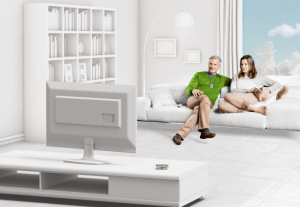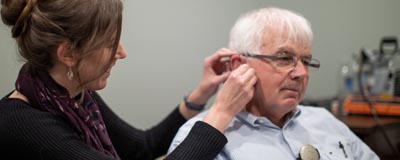Watching TV is a favourite past-time for many Canadians. Unfortunately, understanding television can be difficult for hard of hearing individuals, even with the best hearing aids. With new TV’s getting sleeker and more slender, speakers have been put on the back of the TV. In addition, common placement of televisions are in front of a wall or on a mount on a wall. The placement of the TV and speakers direct sound backwards to the wall. This causes the sound waves to reflect causing distortion before the sound wave reaches your ear. Not to mention that all of the sounds come from the same location. Even with surround sound speakers, it is still a far cry from replicating the sounds in a way that we normally hear as speech and noise typically originate from different directions. Aside from hearing aids, closed captioning and TV accessories are two alternative technologies that help hard of hearing individuals understand television.
Does closed captioning really help?
Closed captioning is an optional feature that allows the viewer to read the dialog on the screen in live time. This can be used to supplement what is being heard. Many individuals find closed captioning helps ensure they don’t miss anything important. A recent study showed that using closed captioning offers a better understanding of television than hearing aids alone. The study involved 15 older adults, all of which had sensorineural hearing losses and wore hearing aids. They participated in a randomized repeated-measures design where participants were tested in four conditions: baseline (no hearing aids or closed captioning), hearing aids only, closed captioning only, and hearing aids + closed captioning. Using closed captioning while watching television was shown to dramatically improve speech understanding, even when hearing aids are worn.
TV Accessories
The use of TV streaming accessories is quite common. Every hearing aid brand offers accessories that will allow you to connect the television directly to most of their new hearing aids. Examples such as the Phonak TV Connector, Widex TV PLAY, ReSound Unite TV and Starkey SurfLink Media are all Television adaptors that directly stream audio to your hearing aids. Some of the other models require the use of an additional device to be worn around your neck. Streaming devices allow you to hear clearly without any reverberation, and at your preferred volume. Meanwhile, others in the room can adjust the television speaker volume so that is comfortable for them. By combining hearing aids, a TV accessory and captioning, you will receive the best understanding of TV.
Reference:
Gordon-Salant, S., Sandra ; Callahan, S., Julia, (2009), The Benefits of Hearing Aids and Closed Captioning for Television Viewing by Older Adults with Hearing Loss, Ear and Hearing, Vol.30(4), p.458-465
Images courtesy of Phonak







